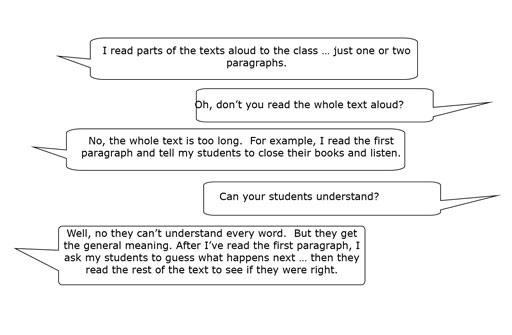2 Asking questions to help students listen
When students do listening activities in English, they should not be expected to understand every word of what they hear. They may just understand a few words. It can be frustrating for students if they don’t understand what they are listening to, so tell them to be patient. The listening activities you do in class should help them develop their listening skills over time. One way to do this is to give your students questions to think about before they listen.
Pause for thought Why do you think that asking questions will help students prepare for listening? |
Just as it is important to ask students questions before they read a text (seethe unit Supporting reading for understanding), asking questions before students listen to something can also help them. It can:
- orient them for what they are going to listen to
- help them learn to pick out key – or important – words, and to use these words to try to understand what is being said
- make them more interested in what they are listening to – when they are trying to find out the answers to the questions while listening, they are listening actively.
In this part of the unit, you look at how you can ask questions to help your students develop listening skills.
Case Study 2: Mr Khan tries an activity to help students listening to a story from the textbook
In Case Study 1, you read about Mr Khan, a secondary English teacher who went to an English language teacher training workshop on how to help students improve their listening skills in English. Here he describes how he tried to use questions to help students understand a story he read to them.
During the workshop, I had to discuss the following question with other participants: ‘How can you get your students to develop their listening skills in the classroom?’ One participant described an activity that she regularly does in the classroom:
I liked this idea and tried it the following week in my English class. The students were doing Chapter 9 of the NCERT Class X textbook. The lesson is called ‘Madam Rides the Bus’ and begins with the following paragraph:
There was a girl named Valliammai who was called Valli for short. She was eight years old and very curious about things. Her favourite pastime was standing in the front doorway of her house, watching what was happening in the street outside. There were no playmates of her own age on her street, and this was about all she had to do.
At the start of the lesson, I asked all of my students to close their books, and then I told them that I was going to read a paragraph about a girl called Valli. I wrote the following questions on the board, and asked my students to write them down in their notebooks:
When the students had finished writing, I asked: ‘Do you understand the questions? Do you know the word “pastime”? A pastime is like “hobby” or “शौक”.’
When I felt certain that they understood the questions, I then asked them to listen carefully to the paragraph, and to listen out for the answers to the questions on the board. I read the paragraph aloud, slowly and clearly. I then told them to see if they could answer the questions in pairs. Many of them couldn’t answer the questions at first, so I read the paragraph aloud again. After that, most were able to answer the questions.
I then asked my students to guess what things Valli would see when she was watching the street outside. Once again, I told them to discuss their ideas in pairs, and to note them down. I gave them a short time limit for this, after which I asked my students to suggest some ideas. They suggested that she might see people travelling in rickshaws, selling goods and so on.
After this, I asked my students to open their books and continue reading the story, and to find out what Valli liked to see the most on the street. The students quickly found that she enjoyed watching the bus.
In this case study, the teacher used a story from the textbook for a listening activity. This activity encourages students to listen for key words, which helps them to understand the main message from words and phrases that they know. If you do it often, students will get used to listening to English without texts in front of them – this will help them to listen to English outside the classroom.
Activity 2: Try in the classroom: helping students to listen for information
You can do this activity to help your students develop listening skills with lessons from your own English textbook. You can also do this with many different texts and for students at any level. This activity can also be done with stories or songs.
Follow the steps below and try using it in your classroom:
- Choose a text from your textbook. Look at the first paragraph. Is it quite short? Could you ask some interesting questions about it?
- Practise reading the paragraph aloud before the class, and prepare two or three questions to ask about the text. (See Resource 2 for some of the classroom language you might need to do this activity.)
- In class, write the questions on the board. Tell your students that you are going to read a text aloud and they should listen to it to find the answers to the questions.
- Read the paragraph aloud. Make sure your students have their books closed.
- Tell your students to discuss the answers to the questions in pairs. If necessary, read the paragraph again to help them answer. For more on the value of discussion, see Resource 3 and the video below.
- Ask them to discuss in pairs what might happen next. Give a short time limit for this. Ask students for some suggestions. This can also be a useful speaking activity, so encourage students to use English. But it is also important that you allow them to respond in their home language too, as this will help you monitor whether they have understood the text.
Pause for thought Here are some questions for you to think about after trying this activity. If possible, discuss these questions with a colleague.
|
If you found it difficult to read the text aloud, you could try practising before class. The more often you read it, the more natural it will become. The questions that you ask students should help them to find the main ideas and the important words in the text. If your students have problems answering the questions, you may need to help them with some of the vocabulary used in the text (see Helping students to learn, use and remember vocabulary for more ideas).
1 Involving students in listening


